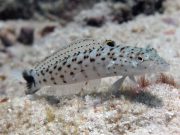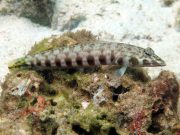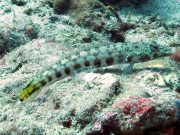Diving with Sandperches
Lanta Marine Life | Pinguipedidae
Sandperches are a family of small to medium sized fish, generally ranging between 12 and 28cm, with a few species slightly smaller or larger than this. Usually seen perched on the sand at every coral reef during Koh Lanta dive trips.
Sandperches have long bodies which are flattened toward the rear and more rounded towards the head. They have long dorsal fins and the head is pointed, with the eyes positioned near the top of the head. The body is usually patterned with spots and bands and most species have distinctive patterns.
Sandperches live on the seafloor and can normally be found over sand or rubble close to the coral reef. These fish feed on small invertebrates, crabs, shrimp and small fish, and tend to sit on the sea bed with their bodies propped up by their pelvic fins.
Sandperches are protogynous hermaphrodites. This means that as juveniles they begin life as females. As they mature, they can change sex to male, and this often goes along with some changes in colour or body patterns. After changing sex, the new male dominates a harem of females and is teritorial. When a male leaves an area, he is replaced by a female, who changes sex and takes over the harem and teritory.
2 species found on this page:
Speckled Sandperch
(Parapercis hexophtalma)

Parapercis hexophtalma @ Koh Haa
The Speckled Sandperch has a generally white body with a slightly greyish back and many dark lines, spots and speckles on the body. The dorsal fin has several rows of small dark spots and there is a large dark blotch on the tail.
The female has a spotted face, and the male has dark wavy lines on the cheeks.
The Speckled Sandperch has a generally white body with a slightly greyish back and many dark lines, spots and speckles on the body.
The dorsal fin has several rows of small dark spots and there is a large dark blotch on the tail. The female has a spotted face, and the male has dark wavy lines on the cheeks.
The Speckled Sandperch grows to 28 cm and is territorial. This species begins as female and changes sex to male later in life, defending a harem of females.
Latticed Sandperch
(Parapercis clathrata)
The Latticed Sandperch grows to 17 cm and has a greyish to tan back with dark blotches. The middle and lower body is white, with a row of brown or dark orange spots with dark centers along the lower body.

Female Parapercis clathrata @ Koh Haa
Adults have a yellow or white streak on the tail, and adult males have a dark ocellated spot above the gill cover.

Male Parapercis clathrata @ Koh Haa
Both juveniles and adults have tiny black spots on the cheeks.

Latticed Sandperches have Dark Spots on the Cheek
Diving with Sandperches around Koh Lanta
Scuba Diving & Snorkel Trips
If you'd love a chance to spot Sandperches on one of our daily high season diving trips from Koh Lanta then send us an email to info@diveandrelax.com.
Join our high season speedboat dive trips to some of Thailand's best dive sites and enjoy small groups, short journey times, with a focus on great personal service, safety and fun.
Not yet a certified diver? Learn to Scuba Dive on Koh Lanta with the 3 day SSI Open Water Diver course.
Book online to save 10% on dive trips and scuba courses on Koh Lanta.
Find Out More
Indo-Pacific Marine Life Guides
- Allen, G., Steene, R., Humann, P., DeLoach, N. (2003) Reef Fish Identification, Tropical Pacific. Jacksonville, FL., USA: New World Publications, Inc., ISBN 1-878348-36-1.
- Humann, P., DeLoach, N., (2010) Reef Creature Identification, Tropical Pacific. Jacksonville, FL., USA: New World Publications Inc., ISBN 978-1-878348-44-9
- Debelius, H. (2013) Indian Ocean Reef Guide. Frankfurt, Germany: IKAN - Unterwasserarchiv, ISBN 978-3-939767-52-7.
- Debelius, H. (2004) Nudibranchs and Sea Snails, Indo-Pacific Field Guide. Frankfurt, Germany: IKAN - Unterwasserarchiv, ISBN 3-925919-51-1
- Erhardt, H., Knop, D. (2015) Corals Indo-Pacific Field Guide. Frankfurt, Germany: IKAN - Unterwasserarchiv, ISBN 3-925919-69-4.
- Veron J.E.N., Stafford-Smith M.G., Turak E. and DeVantier L.M. (2016). Corals of the World
